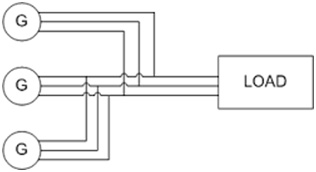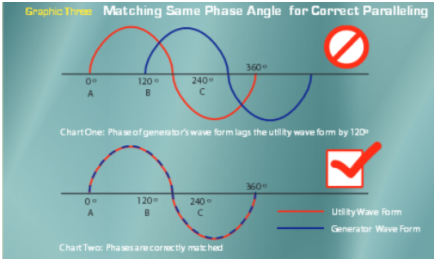Hi everybody, our fellow electrical engineer A.N is one more time spoiling us with a nice article. Check his material below:
Connecting generators in parallel increases the power capacity, control in load management, ease of maintenance, and redundancy. The process involves the physical connection of two or more electric generators, and the synchronization of their outputs.
The synchronization matches the waveform of the output voltage of one generator with the voltage waveform of the other generator (s).
Factors considered when paralleling generators
Capacity: easy of synchronizing the system based on load demand; powering on a set when demand increases and switching off a set when demand decreases.
Redundancy: ensuring a soft power transfer as the outgoing generator is switched off and the incoming one is powered on. The design should avoid a situation where the load is not powered or allowed to run on the UPS.
Compliance with the electrical standards in terms of safely, protection and operation.

Figure 1: Basic connection of parallel connected generators | image: people.ucalgary.ca
Requirements for connecting generators in parallel
Ideally, any type of a generator can be paralleled together with another type as long as their frequencies and voltage are the same at the point of interconnection. However, there are some practical limitations such as incompatibility between older and newer models or when the cost of making them compatible is not justifiable.
Among the things to consider are;
-
- Speed control: The generators may have equal or different engine speeds, but must be locked into the final speed of the system.
-
- Load balance: The entire load should be shared by all the generators according to the capacity of the individual units.
-
- Synchronization: Synchronization is required to ensure that the resulting output is in phase, has the same frequency and voltage hence compatible with load.
- Voltage regulation
Compatible generators
The easiest approach is to use similar generators or at least sets with the same alternator pitch, output voltage and frequency. Generators are said to be compatible when they share some properties such as compatible alternators, engines, speeds, load sharing controls, interfaces to other control and monitoring systems, etc
Incompatible generators
Paralleling generators with different characteristics is a bit complex. Apart from the compatibility issues, there are other system level problems the sizes.
If the sizes are the same, the system is capable of supporting a higher priority load in case of an emergency. However, if the sizes (in KW) are different, the maximum priority load is limited by the smallest generator; otherwise a higher load will overload the generator unless it is prevented from coming up. In such situations, the control is quite complex and might involve changing the sequence of operation. In addition, manual operation as well as dealing with failure modes becomes difficult.
The design should ensure that larger loads are dropped out first in the event of a failure of the bigger generator; this ensures that the smaller generator will be left with a load it can support.
Synchronizing parallel connected generators
This is the process in which the voltage and frequency of the generators are matched to provide a standard AC output waveform.
For the generators to be paralleled and synchronized correctly, each of the sets should have the below characteristics
-
- Frequency: the frequencies must be the same
-
- Voltage: The generators should produce or be set to produce the same voltage
-
- Phase number: The two systems should have the same number of phases, either three or single phase.
-
- Phase rotation: For three phase systems, each of the three phases must be matched. This prevents excessive mechanical and electrical stresses as well as avoiding power surges.
- Voltage Phase angle: The waveforms should be matched such that they rise and fall together. There should be no angle difference and the potential difference between the phases should be zero.

Figure 2: Matching phase angle | image: cpower.com
Advantages of Parallel generator systems
Increased reliability and redundancy: Improving reliability and redundancy for both critical and non-critical loads. The system ensures that there is always constant power to critical loads, and if one of the generators fails, the load is supplied by the other one or more parallel unit.
Low cost of power generation: Cost of generation increases with generator size and is more for ratings above 600KW.This is due to the fact that the market for smaller engines is higher, hence more are manufactures, resulting in lower cost. Using several smaller generators becomes more economical than a single large generator.
Decreased light loading of the generator prime mover: In most installations, the load varies from time to time and it is common to have a generator running at 30% of its capacity when the load is low. This may cause wet stacking. The efficiency of the prime mover is normally higher when the load is between 75% and 100%, and a light load means that the generator operation is inefficient. Using a smaller generator increases efficiency, hence a cost reduction.
More control and savings on generating costs: The total amount of power supplied from several small generators is equal to the power supplied by one large unit. However, there is more control and balancing in the smaller generators. One can balance the load over the different circuits, and decide on the power to generate at any particular time based on the load.
- The parallel system can achieve huge savings when all generators are operated above 75% of their rated load. This is the point at which generators use the minimum fuel.
Expandability and flexibility: The use of several generators makes it possible to supply a varying load without piling up costly units or spending too much on a big generator whose full capacity is rarely used. Generators can be added gradually as demand increases.
Conclusion
Setting up parallel generators is a complex procedure that requires a qualified electrical professional.
A well designed system provides backup power and a variable output. Using the correct paralleling switchgear helps the consumer to achieve the maximum output when the power demand is at its peak while providing the minimum output when the load requirements are low.
Thank you for reading,
A.N.
And that’s it! Did this article help? What more can you add about this topic?
May you synchronize either delta or Wye winding generators to the same bus as long as both have the same frequency, voltage and phase angle? Thanks!
Dear Sir.
1- I have 2 single phase Chinese electric generator 220 v, running 7.5 KW each.
I need to run my work with total 14 kw.
Can I joint 2 generators wires in parallel and get up-to 15 KW power (Red to Red, Black to Black & Earth to Earth)?
2- I have a supply of 3 phase 4 wires 400 V 50 HZ electricity 5 kw.power. All my equipment are single phase, total power required 15 kw/h.
Can I joint 5 kw single phase equipment 220 V to each phase (R with B or Y with B or B with B) to get total 15 kw?
If can’t get 5kw from each phase, what is the maximum load can get from this 5kw 3 phase cable?
Best regards
Badeea Alobeidli
Dubai, UAE
Today there are Auto Synchronizers that synchronize generator and close the breaker automatically. Most of operators are probably not aware of what is actually happening before breaker closed event and after it.
My days it was all done manually.
Here is a small online simulator that allows user to get some experience by synchronizing an imaginary generator to grid.
The generator has no protection as you can’t brake it anyhow. It has a rudimentary excitation and a simple drooped turbine governor.
hello pero, where is the online simulator that allows user to get some experience by synchronizing an imaginary generator to grid, can you please share the link or name of simulator with me please?
I am interested in two Lifan ESI7000iER-EFI in the Hope’s of a parallel set-up. Is it possible to Parallel these 2 generators. And…
– If they are 30amp each, does that mean it is still a max of 30 amps combined?
– Do I need a synchronization panel for this set-up or since they are identical models and both new they can be wired in parallel?
I look forward to your response.
i have two generators , 1500KVA each with synchronization panel. when one work wnd then load become more and needs the other to share , the synchronisation taks a long time as much as more than 3 minuts.
any body tell me the reason and how to minmize the time.
Client needs less than one minut.
regards.
Akram.
What controllers are you using please give me some details please what is the time set for the breaker to close
Dear sir,
Thanks for your info.
I am opertaing generators in parallel in a factory ( oil plant) and now users recommend UPS in parallel with generators for max safety of the plant.
What problems can I expect in thus parallel operation?
I am in a little at a loss as such a operation is new to me and I think there must be matters to be raised
on such operation!
please help me out!
Ji
i have a system withtwo generators the control panel is a countryman synchro parell panel i keep getting a reverse power condition can any one share some light on this system please the generators are 800 460 60 hz by 600 kw 60 hz 460 volts using a ils barber colman and a silver line synchronize
Thank you
Anthony
Using this method is it possible to connect two WEN 4750-Watt 120V/240V Dual Fuel Portable Generator together in order to operate my 3hp 360 foot deep well.
I always spent my half an hour to read this web site’s content all the time along with a mug of coffee.